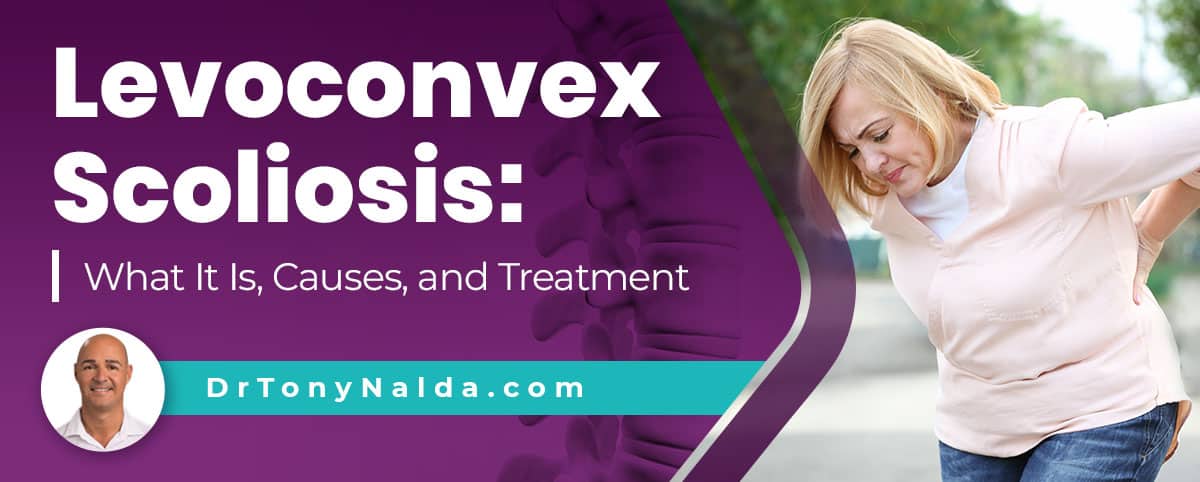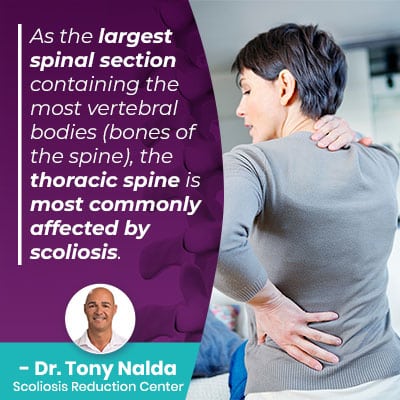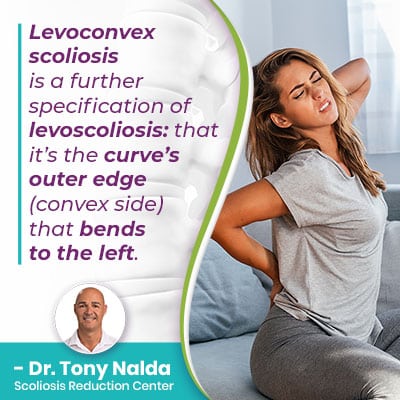Levoconvex Scoliosis: What It Is, Causes, and Treatment

Not only can scoliosis range greatly in severity, but there are also multiple condition types, curvature locations, and curvature types and patterns. Levoconvex scoliosis is a type of medical term likely found in a radiography report; it classifies the condition by indicating that the scoliotic curve bends to the left on its convex side. Continue reading to learn the specifics of what makes levoconvex scoliosis atypical.
When scoliosis is first diagnosed, it’s further classified based on specific patient/condition variables. Levoconvex scoliosis is a further specification that the scoliotic curve’s outer edge (convex side) curves to the left. Causes and treatment needs are case-specific.
Before narrowing our discussion to the specifics of levoconvex scoliosis, let’s first talk generally about the condition and why classification is an important part of the diagnostic process.
Table of Contents
Scoliosis Classification
A diagnosis of scoliosis means an unnatural sideways spinal curve, with rotation, has developed, and as such a complex and highly-variable condition, no two cases are the same, which is why further classification is part of the diagnostic process.
Scoliosis is also a 3-dimensional condition due to its rotational component; the unnatural sideways spinal curve doesn’t just bend unnaturally to the side but also rotates from back to front, front to back.
Classifying scoliosis isn’t just important because it streamlines the treatment process between different treatment providers and care facilities but also because it specifies the key patient/condition variables needed to shape effective treatment plans.
The main variables for classifying scoliosis are patient age, condition severity, curvature location, and condition type (cause).
Patient Age
Patient age is important because it indicates overall health and fitness and tells me how likely a patient is to find their condition painful and what its progressive rate is most likely to be.
While the most prevalent type of scoliosis is adolescent idiopathic scoliosis (AIS), diagnosed between the ages of 10 and 18, it can also affect infants, juveniles, adults, and the elderly.
While children and adolescents can most certainly experience some condition-related muscle pain, it terms of back pain, patients who have not yet reached skeletal maturity don’t commonly find their scoliosis overly painful. This is because a growing spine is experiencing a constant lengthening motion, and that lengthening motion counteracts compression, which is the main source of condition-related pain.
Compression of the spine, and its surrounding muscles and nerves, occurs when scoliosis becomes a compressive condition in adulthood, once skeletal maturity has been reached and the spine has settled due to maturity and gravity.
While we don’t understand why idiopathic scoliosis initially develops, we do know how to treat it, and we know what triggers its progression: growth and development.
So young patients who are still growing are at risk for rapid-phase progression, which is why one of the treatment focuses with young patients is closely monitoring for growth/progression and working to counteract the condition’s progressive nature throughout growth.
Condition Severity
Scoliosis can range greatly in severity, and this is determined by a measurement known as Cobb angle, taken during X-ray, that involves drawing intersecting lines from the tops and bottoms of the curve’s most-tilted vertebrae. The resulting angle is expressed in degrees and places conditions on a severity scale of mild to moderate, severe, and very severe:
- Mild scoliosis: Cobb angle measurement of between 10 and 25 degrees
- Moderate scoliosis: Cobb angle measurement of between 25 and 40 degrees
- Severe scoliosis: Cobb angle measurement of 40+ degrees
- Very-severe scoliosis: Cobb angle measurement of 80+ degrees
Condition severity tells me how far out of alignment a scoliotic spine is, and as a progressive condition, where scoliosis is at the time of diagnosis is not indicative of where it will stay.
Mild scoliosis can easily become moderate, severe, or very severe if left untreated or not treated proactively.
Just because scoliosis is a progressive condition doesn’t mean patients have to experience progression; chiropractic-centered treatment can help counteract the condition’s progressive nature and prevent increasing condition severity.
For patients undergoing traditional scoliosis treatment, they tend to get funneled towards spinal fusion surgery, quite simply because the approach doesn’t have a strategy for treating mild scoliosis, so it doesn’t respond proactively to a diagnosis, and chooses, instead, to merely watch and wait until severe enough to warrant a spinal-fusion recommendation.
Spinal fusion has its place in scoliosis treatment, but like all surgical procedures, it comes with its share of potential risks, side effects, and complications, not to mention the fact that it’s costly, invasive, and can cause a significant loss of spinal flexibility and range of motion.
Here at the Scoliosis Reduction Center, I address condition severity, and other important variables, by integrating multiple types of condition-specific treatment capable of impacting the condition on multiple levels: chiropractic care, in-office therapy, custom-prescribed home exercises, and corrective bracing.
Curvature Location
 Scoliosis can develop in any spinal section, and there are also distinct curvature types/patterns that further specify conditions.
Scoliosis can develop in any spinal section, and there are also distinct curvature types/patterns that further specify conditions.
Where along the spine scoliosis develops is important because it tells me where I need to concentrate my treatment methods and because it helps indicate likely symptoms and progressive rates.
There are three main spinal sections: cervical (neck), thoracic (middle/upper back), and lumbar (lower spine).
Scoliosis can develop in any one spinal section or in more than one section as a combined scoliosis, as is the case with thoracolumbar scoliosis that develops both in the lower thoracic and upper lumbar spinal sections.
As the largest spinal section containing the most vertebral bodies (bones of the spine), the thoracic spine is the spinal section most commonly affected by scoliosis.
When it comes to condition type, determined by causation, scoliosis is considered typical or atypical.
Condition type
The majority of scoliosis cases, approximately 80 percent, are classified as idiopathic, meaning not clearly associated with a single-known cause, and the remaining 20 percent have known causes: neuromuscular, congenital, degenerative, or traumatic.
Now, in typical idiopathic cases, the curve will bend to the right, away from the heart, known as dextroscoliosis, but when a scoliotic curve bends to the left, towards the heart, known as levoscoliosis, this is considered atypical and is a red flag that there is an underlying pathology; this is important because when the cause is known, it becomes the guiding force behind the design of effective treatment plans.
For example, in cases of neuromuscular scoliosis (NMS), we know that the scoliosis develops as a secondary complication of a larger neuromuscular condition, such as cerebral palsy, muscular dystrophy, and spina bifida, to name a few.
 The larger neurological condition that caused scoliosis to develop is its underlying cause, so that has to be the guiding force of the treatment, which complicates the treatment process and is why I can’t offer my NMS patients the same types of outcomes I’ve achieved with typical scoliosis cases.
The larger neurological condition that caused scoliosis to develop is its underlying cause, so that has to be the guiding force of the treatment, which complicates the treatment process and is why I can’t offer my NMS patients the same types of outcomes I’ve achieved with typical scoliosis cases.
So now that we understand a bit more of the scoliosis-classification process let’s move on to the specifics of levoconvex scoliosis.
What is Levoconvex Scoliosis?
As mentioned, in typical forms of scoliosis, the unnatural spinal curve bends to the right, away from the heart, but in atypical forms, it bends to the left, towards the heart: levoscoliosis.
Levoconvex scoliosis is a further specification of levoscoliosis: that it’s the curve’s outer edge (convex side) that bends to the left. The term concave refers to a curve’s inner edge.
Levoconvex scoliosis is also known as thoracic levoscoliosis because it most commonly affects the thoracic spine, although it can also affect the lumbar spine.
Conclusion
There’s no shortage of complex and confusing medical terms being tossed around when a condition is first diagnosed; understanding some of the basic medical terms used to classify scoliosis can help patients process and fully understand the condition they’re living with.
As no two scoliosis cases are the same, customizing treatment plans is key, and classifying conditions based on important patient/condition variables helps craft effective treatment plans.
As a progressive condition, proactive treatment is needed to stay ahead of its progressive line and prevent increasing condition severity, escalating symptoms, and the need for more invasive treatment, like surgery, in the future.
If a diagnosis of levoconvex scoliosis is given, this means the unnatural spinal curve bends to the left, which is considered atypical, and the curve’s outer edge (convex side) rather than its inner edge (concave side) bends to the left.
With levoconvex scoliosis, there is an underlying pathology making the condition atypical, such as a neuromuscular condition, a congenital malformation within the spine itself, trauma experienced by the spine, or tumors pressing on the spine and forcing it out of alignment.
Here at the Center, I’ve treated all forms and types of scoliosis, and treatment plans are designed around their underlying cause and other important classification points.
Once I’ve impacted conditions on a structural level, in the form of a curvature reduction, I can shift the focus to increasing core strength, so the spine is optimally supported and stabilized by its surrounding muscles.
Dr. Tony Nalda
DOCTOR OF CHIROPRACTIC
After receiving an undergraduate degree in psychology and his Doctorate of Chiropractic from Life University, Dr. Nalda settled in Celebration, Florida and proceeded to build one of Central Florida’s most successful chiropractic clinics.
His experience with patients suffering from scoliosis, and the confusion and frustration they faced, led him to seek a specialty in scoliosis care. In 2006 he completed his Intensive Care Certification from CLEAR Institute, a leading scoliosis educational and certification center.
About Dr. Tony Nalda
 Ready to explore scoliosis treatment? Contact Us Now
Ready to explore scoliosis treatment? Contact Us Now





